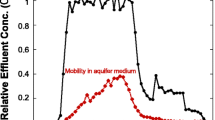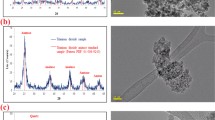Abstract
Groundwater remediation using iron oxide and zero-valent iron nanoparticles (NPs) can be effective, but is limited in many applications due to the NP strong retention in groundwater-saturated porous media after injection, the passivation of the porous surface, and the high cost of nanomaterials versus macro scale iron. In this study, we investigated transport of bare and polymer-coated 2-line ferrihydrite NPs (30–300 nm) in saturated aquifer sediments. The influence of poly(acrylic acid) (PAA) polymer coatings was studied on the colloidal stability and transport in sediments packed column tests simulating groundwater flow in saturated sediments. In addition, the influence of calcium cations was investigated by transport measurements using sediments with calcium concentrations in the aqueous phase ranging from 0.5 (typical for most sediments) to 2 mM. Measurements were also made of zeta potential, hydrodynamic diameter, polymer adsorption and desorption properties, and bio-availability of PAA-coated NPs. We found that NP transport through the saturated aquifer sediments was improved by PAA coating and that the transport properties could be tuned by adjusting the polymer concentration. We further discovered that PAA coatings enhanced NP transport, compared to bare NPs, in all calcium-containing experiments tested, however, the presence of calcium always exhibited a negative effect on NP transport. In tests of bioavailability, the iron reduction rate of the coated and bare NPs by Geobacter sulfurreducens was the same, which shows that the PAA coating does not significantly reduce NP Fe(III) bioavailability. Our results demonstrate that much improved transport of iron oxide NP can be achieved in saturated aquifer sediments by introducing negatively charged polyelectrolytes and optimizing polymer concentrations, and furthermore, these coated NPs retain their bioavailability that is needed for applications in bio-environmental remediation.



Similar content being viewed by others
References
Anderson RT, Vrionis HA, Ortiz-Bernad I, Resch CT, Long PE, Dayvault R, Karp K, Marutzky S, Metzler DR, Peacock A, White DC, Lowe M, Lovley DR (2003) Stimulating the in situ activity of Geobacter species to remove uranium from the groundwater of a uranium-contaminated aquifer. Appl Environ Microbiol 69:5884–5891
Choi H, Al-Abed SR, Agarwal S, Dionysiou DD (2008) Synthesis of reactive nano-Fe/Pd bimetallic system-impregnated activated carbon for the simultaneous adsorption and dechlorination of PCBs. Chem Mater 20(11):3649–3655. doi:10.1021/cm8003613
Cornell RM, Schwertmann U (2003) The iron oxides: structure, properties, reactions, occurrences and uses. Wiley-VCH, Weinheim
Ghosh S, Jiang W, McClements JD, Xing B (2011) Colloidal stability of magnetic iron oxide nanoparticles: influence of natural organic matter and synthetic polyelectrolytes. Langmuir 27:8036–8043. doi:10.1021/la200772e
Holsen TM, Taylor ER, Seo YC, Anderson PR (1991) Removal of sparingly soluble organic chemicals from aqueous solutions with surfactant-coated ferrihydrite. Environ Sci Technol 25:1585–1589. doi:10.1021/es00021a009
Hunter RJ (1988) Zeta potential in colloid science: principles and applications. Academic Press, New York
Komlos J, Jaffé PR (2004) Effect of iron bioavailability on dissolved hydrogen concentrations during microbial iron reduction. Biodegradation 15:315–325
Komlos J, Peacock A, Kukkadapu RK, Jaffé PR (2008) Long-term dynamics of uranium reduction/reoxidation under low sulfate conditions. Geochim Cosmochim Acta 72(15):3603–3615
Moon HS, Komlos J, Jaffé PR (2007) Uranium reoxidation in previously bioreduced sediment by dissolved oxygen and nitrate. Environ Sci Technol 41(13):4587–4592
Moon HS, McGuiness L, Kukkadapu RK, Peacock AD, Komlos J, Kerkhof LJ, Long PE, Jaffé PR (2010) Microbial reduction of uranium under iron- and sulfate-reducing conditions: effect of amended goethite on microbial community composition and dynamics. Water Res 44:4015–4028. doi:10.1016/j.watres.2010.05.003
Murdock RC, Braydich-Stolle L, Schrand AM, Schlager JJ, Hussain SM (2008) Characterization of nanomaterial dispersion in solution prior to in vitro exposure using dynamic light scattering technique. Toxicol Sci 101(2):239–253. doi:10.1093/toxsci/kfm240
Quinn J, Geiger C, Clausen C, Brooks K, Coon C, O’Hara S, Krug T, Major D, Yoon WS, Gavaskar A, Holdsworth T (2005) Field demonstration of DNAPL dehalogenation using emulsified zero-valent iron. Environ Sci Technol 39(5):1309–1318. doi:10.1021/es0490018
Schrick B, Hydutsky BW, Blough JL, Mallouk TE (2004) Delivery vehicles for zerovalent metal nanoparticles in soil and groundwater. Chem Mater 16(11):2187–2193. doi:10.1021/cm0218108
Straub KL, Benz M, Schink B (2001) Iron metabolism in anoxic environments at near neutral pH. FEMS Microbiol Ecol 34(3):181–186
Tan KH (2011) Principles of soil chemistry. Taylor and Financial Group CRC Press, Boca Raton
Tiraferri A, Sethi R (2009) Enhanced transport of zerovalent iron nanoparticles in saturated porous media by guar gum. J Nanopart Res 11:635–645
Xiang A, Yan W, Koel BE, Jaffé RP (2013) Poly(acrylic acid) coating induced 2-line ferrihydrite nanoparticle transport in saturated porous media. J Nanopart Res 15:1705–1713
Zouboulis AI, Katsoyiannis IA (2005) Recent advances in the bioremediation of arsenic-contaminated groundwaters. Environ Int 31:213–219
Acknowledgments
The authors acknowledge support of the Andlinger Innovation Fund of the Andlinger Center for Energy and the Environment at Princeton University. The authors thank Prof. Robert Prud’homme for his valuable discussions and his group for assistance.
Author information
Authors and Affiliations
Corresponding author
Electronic supplementary material
Below is the link to the electronic supplementary material.
Appendix
Appendix
Desorption dynamics of PAA from 2-line ferrihydrite NP surfaces in a dilute solution
Data shown in Fig. 4 were used to determine a desorption rate of 47.73 mg PPA/g NP/h for 8 mg/l PAA-coated 2-line ferrihydrite NPs in an infinitely dilute solution containing a carbonate/bicarbonate buffer at pH 8. This demonstrates that PAA will detach from the NPs and be lost into the groundwater when the coated NPs are contacted with fresh groundwater.
Rights and permissions
About this article
Cite this article
Xiang, A., Zhou, S., Koel, B.E. et al. Transport of poly(acrylic acid) coated 2-line ferrihydrite nanoparticles in saturated aquifer sediments for environmental remediation. J Nanopart Res 16, 2294 (2014). https://doi.org/10.1007/s11051-014-2294-5
Received:
Accepted:
Published:
DOI: https://doi.org/10.1007/s11051-014-2294-5





